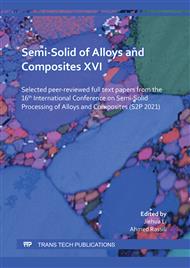p.197
p.207
p.223
p.231
p.238
p.244
p.250
p.255
p.263
Recent Industrial Application and Perspectives of Rheo-Diecast Process in China
Abstract:
The Rheo-diecast process has been rapidly developed and increasingly used in China in the recent 5 years. The high solid fraction (solid content close to 50%) rheo-diecast components were commercially used in the transportation markets mainly because of lightweight. The mechanical properties of the high solid fraction rheo-diecast components are obviously superior than that of the conventional liquid diecast parts. The defects such as oxide, gas entrapment, shrinkage porosities are well prevented in the high solid fraction rheo-diecast parts. The high solid fraction rheo-diecast parts can be fully T6 heat treated. A comparison between high solid fraction rheo-diecast part and conventional liquid diecast part will be described in detail. The low solid fraction (solid content 5-20%) rheo-diecast components were widely used in the 5G communication markets. The future perspectives of Rheo-diecast process will be described at last. 1. Cost reduction. 2. Production consistency. 3. New Rheo-diecast alloys development. 4. Numerical simulation of Rheological filling.
Info:
Periodical:
Pages:
238-243
Citation:
Online since:
January 2022
Authors:
Keywords:
Price:
Сopyright:
© 2022 Trans Tech Publications Ltd. All Rights Reserved
Share:
Citation:


